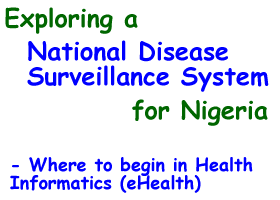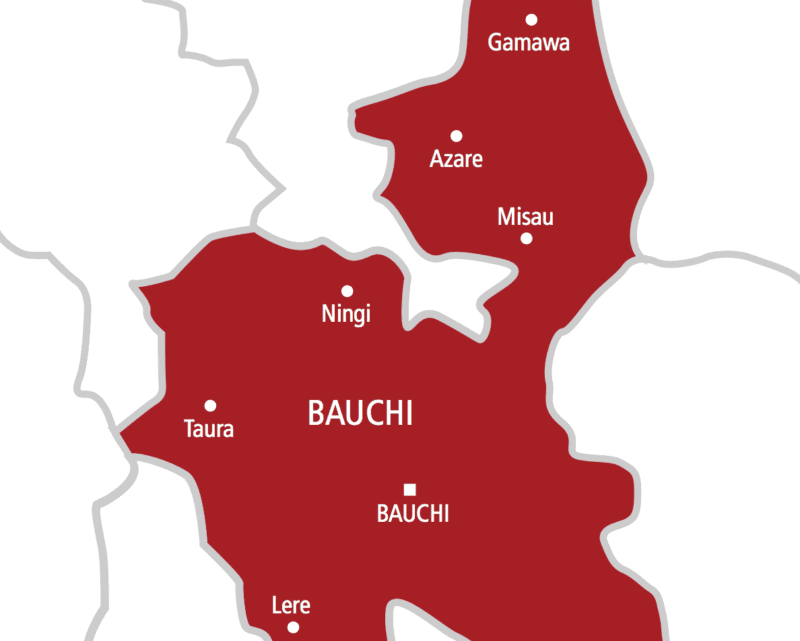Global Issues
Post EBOLA – Exploring a National Disease Surveillance System for Nigeria – Part 3 of 4

Where to Begin in Health Informatics (eHealth)?
BACKGROUND:
In my two previous articles, Post EBOLA – Exploring a National Disease Surveillance System for Nigeria Part 1 and Part 2, I introduced the real need for Nigeria to have a National Health eSurveillance System for diseases like Ebola, HIV, Tuberculosis, Malaria amongst others; as well as a health system to achieve the massive economic benefits that will accrue to Nigeria by having a healthier population resulting from an enhanced health system based on accurate and timely information derived from eHealth systems. This economic benefit was calculated based on the 2001 UN WHO report ‘Macroeconomics and Health: Investing in Health for Economic Development’.
The big challenge in this journey, given all of the components of a national health system, is where to start? This is particularly challenging in the subject area of Health Informatics which all too often is seen to be a task that is straightforward, which in fact is not at all the case. In order to put this reality in perspective a visit to the site ‘Grand Engineering Challenges of the 21st Century’ is recommended. Published by the National Academy of Engineering in the USA the site lists among the 14 Grand Challenges: ‘Reverse-engineer the brain’, and the one that we are exploring ‘Improve Health Informatics’.
As we will see in future articles, many of the developing countries, and to a lesser extent, some of the developed countries, have encountered numerous very costly eHealth failures over the past thirty years, mainly because they did not know where to start, essentially taking on more initially than they could handle both financially and technically.
Since failure is not an option in Nigeria, we show herein how to get STARTED in eHealth – with PAS/S (Patient Administration System/Surveillance) – and in future articles to then expand over the years to a national integrated eHealth system for all public hospitals and public health clinics by capturing the required patient health data in e-format at the point-of care, and subsequently at all other points-of-care.
The two main choices as to where to begin in eHealth are either PAS/S or HIS
When Health Ministries in a developing country look at the many health-related applications, it usually boils down to a choice between two philosophical concepts as to how to best start in order to get this important eHealth initiative underway. The main choices are:
-
To start with an HIS (Hospital Information System), often from a single
vendor, which involves the implementation of more than twenty application
software modules, over a period of a few years. A partial list of these
many application software modules is enclosed. Or, -
To start with the PAS/S (Patient Administration System)/Surveillance module,
the core HIS module only, and implement the PAS/S in all of the public hospitals
and clinics within the country before moving on to the next application
software modules (Clinical Laboratory, Pharmacy, Radiology, etc.).
Let’s take a pragmatic look at these two options for developing countries. Since Heron deployed the world’s only working surveillance system in a developing country, I have sought out its straightforward opinions, plus its supporting reasons, for the choice as to how to start in health IT. All of the HIS-attempted initiatives, known to Heron, in such countries as India, South Africa, Pakistan, Botswana, Malaysia, Panama, etc., have failed, so this approach is at best a huge gamble, and at worst a serious 75% anticipated failure outcome. Why gamble with health funds when it is not necessary?
The PAS/S Approach:
The core module within an HIS is the PAS/S module, to which all subsequent clinical application software modules will be connected. Accordingly, it is the first software module to be implemented, and there need not be a fixed timeline before moving on to the subsequent application software modules.
Question 01: What is the chance of success when a country starts its health IT with a PAS/S?
Response: Very high, and close to one hundred percent (100%) – if managed properly.
The PAS/S implementation has no mandatory deadline, so the challenges that are encountered along the way can be attended to without involving the many other hospital departments, and having to interface to many other software modules.
Question 02: What are the application software components of a PAS/S suite?
Response: The PAS/S module constitutes about 15% of a complete HIS. There are many components within PAS/S, and the order of implementation can be changed to suit the availability of key personnel, financial resources, and to suit the priority of the different department managers. The key PAS/S application modules are:
- Central Patient Index (Master Patient Index)
- Registration
- Outpatients
- Billing and Accounts Receivable
- Accident and Emergency Department
- Health Records Abstracting (ICD-10)
- Surveillance (Ebola, Injury, TB, HIV/AIDS, etc.)
Question 03: When did the developed countries start to computerize their PAS in public hospitals?
Response: In Canada, as in the USA and Europe, most hospitals started to computerize their operations around 1970 with the financials, and billing in USA hospitals. It was not until the very late 1970s that Canadian hospitals (1978) started to implement the Patient Administration System. Hospitals in Canada have not been able to implement eSurveillance Systems because there are no standard data sets in use, as various hospitals have PAS implementations from different vendors.
Question 04: Is it prudent to implement the PAS/S concurrently with other clinical modules?
Response: No, it is not a suggested approach. Heron has observed that this key core module, the PAS/S, can be successfully implemented best when there are no outside pressures to concurrently implement additional clinical software modules. These other modules must be integrated to the PAS/S, so the PAS/S must be very stable first before being connected to other modules.
However, the PAS/S can be concurrently implemented with some financial modules, for the General Ledger is often desired early on, and the PAS/S provides the G/L with certain data, and it is desirable that such provided data be verified by G/L account codes.
Question 05: How long would it take to implement PAS in a typical country, and at what cost?
Response: There are numerous factors involved in addressing this matter, among them:
- The number of public hospitals and clinics in the country:
- In Jamaica the first 5 hospitals (Phase I) were live within the first
year. - The Phase II hospitals (six) all went live over a period of six days, with the initial training having been completed well in advance.
- In Nigeria there are thousands of hospitals, so this must be carefully planned. Phase 1 involving a few hospitals will provide proof-of-concept quickly and with minimum expense.
- In Jamaica the first 5 hospitals (Phase I) were live within the first
- The resources (personnel and financial) that the government applies to the initiative are very important, and are dependent on the annual public health budgets.
- Nigeria spends about US $25 per year per capita on public health.
- Jamaica spends about US $129
per year per capita on public health. - Canada spends about US $3,009 per year per capita on public health. An estimate of the cost to Nigeria of a PAS/S follows shortly.
- The continuity of the key people overseeing the initiative is critical.
- The initiative must have a high-level executive, ‘a key Champion’, to direct a problem free implementation.
- The status of the hospital infrastructure (air conditioning, wiring, etc.)
- In summary, in a country with 20-200 public hospitals it should be possible to implement the PAS/S successfully in all hospitals within 3 to 5 years. Nigeria will require about 10+ years.
- The cost of a PAS/S implementation in a specific country, from the software perspective, will vary based on the GDP per capita of the country. An example of the upfront costs can be deduced by looking at the country’s current health budget. Heron bases its national PAS/S license fee within 0.5% of this budget, amortized over 10 years. When the required training costs, plus the necessary hardware and on-going support fees are included, the annual PAS/S expenditure would be about 1% – 2% of the health budget. In Canada today about 3.0% of the health budget is spent on IT (for an HIS), or about US$100.00 per capita. Allocating 1/6th to the PAS component we see that about $15.00 is for the PAS. In Jamaica, the current PAS/S IT cost is in the range of $0.85, less than 10% of what Canada spends – per capita.
Question 06: Which application software module comes next after the successful PAS?
Response: The choice as to the next application software module will vary greatly from country to country. It appears that the two most needed modules after the PAS/S are Pharmacy and Clinical Laboratory, with no particular order.
Question 07: How long might it take to achieve a complete HIS/EHR implementation?
Response: The length of time required varies greatly from country to country, and is mainly dependent upon the resources available, as noted above. While benefits will be obvious within a few months of starting, the minimum time is estimated at about ten years, with the more likely time frame being in the order of twenty years.
Question 08: Why does Heron understand the correct and successful health IT approach?
Response: Heron has had the first-hand opportunity to compare costs and business practices in the health sector of both the developed (since 1972) and developing countries (since 1995). Also, extensive research has been done in looking closely at the health IT failures around the world, and in studying the reports that sometimes appear. For example, in South Africa, the Medical Research Council prepared an extensive 87-page report on the failed HIS attempt in Limpopo province (1998). Heron has prepared several comparative reports on this US$50 million HIS failure.
Having worked closely with many developing countries over many years has provided Heron personnel with a much better appreciation of the business process in these countries, and how to work within this business process to achieve success. Understanding the health IT failures provides significant insight into the technology, and how to avoid failure. There are always lessons to be learned, and these lessons must be then put into practice. This paper on why the PAS/S approach should be the starting point in national health IT is built upon the many lessons learned.
In my next article we will look at lessons learned from various Health Information Systems implementation around the world and how a developing country like Nigeria could avoid the costly mistakes by employing proven and working systems like Heron PAS/S as a starting point for HIS roll-out.
About the Author:
Kenneth Nwosu is an eHealth Professional based in Toronto ON Canada and can be reached at nwosukc@mcmaster.ca.



















